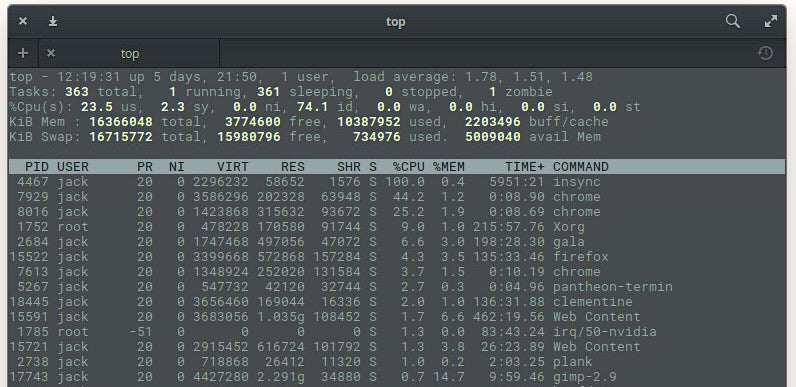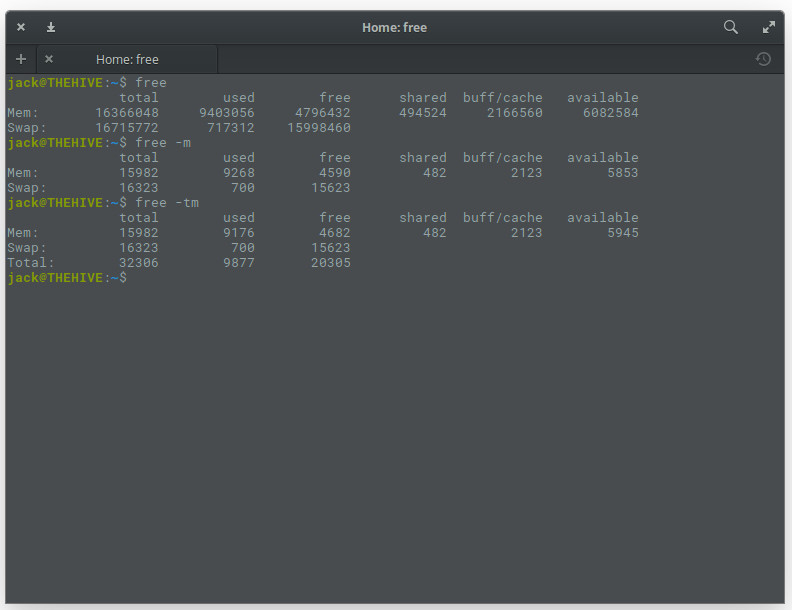Display available memory on Linux Ubuntu Run this command from a terminal window. Total used free shared buffcache available Mem.

Find Ram Size In Linux Using Free And Top Commands Nixcraft
This works on debian ubuntu and redhat.

Linux show total memory available. A better way to track the total memory consumed by your process would be to use top 1 and look at VIRT which includes memory swapped out or RES which only includes physical memory. Grep MemTotal procmeminfo. If you prefer to see information in MB you can use the -m parameter like this.
Like the free command vmstat virtual memory statistics is also available on most Linux distributions. To find free memory free total - used buffcache free 1863224 - 966628802012 94584 which is correct. As you can see all you have to do is use the Linux cat command on a special file on your Linux system.
That command returns results like this. Linux comes with different set of commands to check memory usage. The free command line options are as follows.
You can use the grep command to narrow or filter the output down to the memtotal row or a set of rows which shows you the total installed memory on your system. Whether you are a digital nomad or just looking for flexibility Shells can put your Linux machine on the device that you want to use. Cat procmeminfo You should see results similar to this.
Im sure it works on others but those are the only ones I have access to. What is the difference between available and free memory. So it is typical for Linux to use 90 of all available physical memory not long after boot.
At the top of the vmstat output you can see the total memory the used memory the active memory which is equivalent to the used memory the inactive and the free memory. But if you do want to use procmeminfo then the formula I would use would be. By default when we type the vmstat command it will print the free buffered and cached memory alongside swap CPU IO and system information.
You should see something similar to the following as output. MemTotal MemFree Cached Buffers SwapCached. You can show free memory on a Linux system with the free command like this.
Type the following command. The vmstat command reports information about processes memory paging block IO traps and cpu activity. See below for sample processor output How to show Linux memory information To see your Linux memory information and memory stats use this command.
Cat procmeminfo See below for sample output Linux processor command output. How to script link navigation. 1863224 966628 94584 88584 802012 620712 Swap.
You can check memory usage with the free command as follows. Sign up to receive insightful content. And dirty swap usage this gives you a better overall picture.
8145044 8097552 47492 0 74252 1189464 - bufferscache. Open the command line. The free command displays the total amount of free and used physical and swap memory in the system as well as the buffers used by the kernel.
How to calculate available memory. This Linux command will show the amount of OS RAM available to an Oracle server. With over 10 pre-installed distros to choose from the worry-free installation life is here.
Look at what the kernel has committed itself to providing. Total used free shared buffers cached Mem. Free is a command that displays the total memory usage information of the system.
Those columns are very similar to the columns displayed using the free command. See my notes on using ipcs to measure system RAM. Free is shipped with almost all the Linux distribution by default.
Ipcs -pmb You can also see the total amount of SGA RAM on an individual instance with the SQLPlus command show sga. -b-k-m-g show output in bytes KB MB or GB -l show detailed low and high memory statistics -o use old format no -bufferscache line -t display total for RAM swap -s update every delay seconds -c update count times -V display version information and exit. Get a virtual cloud desktop with the Linux distro that you want in less than five minutes with Shells.
This is the total physical memory on the system. Linux uses memory very efficiently any blocks not promised to some process is used to cache recentlyfrequently accessed files. As with almost all other commands you can use grep as in this example.
This is your total available memory. Free The free command without any command-line options displays the memory and swap usage information in the Kibibytes unit.

5 Commands For Checking Memory Usage In Linux Linux Com

5 Commands For Checking Memory Usage In Linux Linux Com

How To Check Memory Usage Per Process On Linux